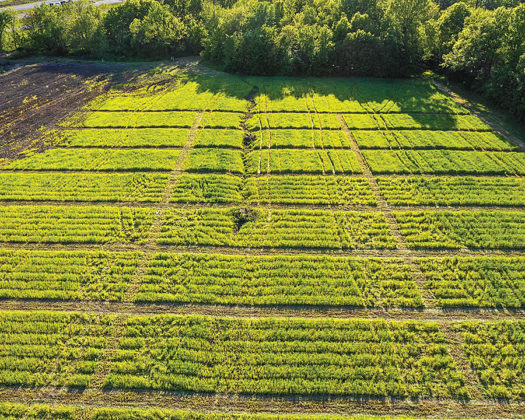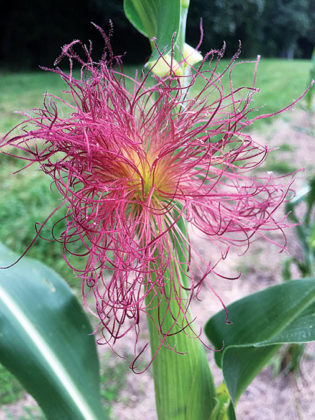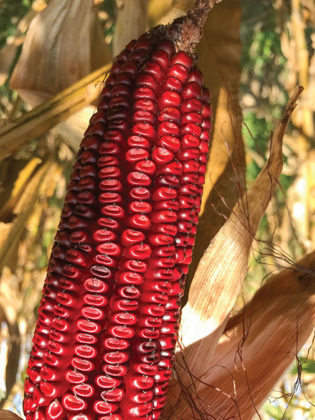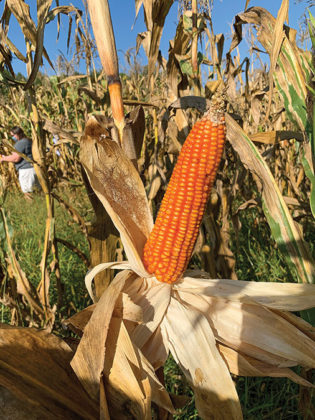You are what you eat.
We scan labels for details of where the ingredients were grown, where livestock was reared, the exact variety of apple. Food sure, spirits? Not so much. A label will likely reveal the percentage of rye to corn, or what barrel it’s been aged in and for how long. But there’s little information on the grain itself. And, if there was, it is likely not worth printing, as chances are most bottles (at a commercial level especially) are going to say a similar thing.
Industrialization of the farming industry has seen small holdings and landraces evolve into agribusiness. Some sites sprawl 190,000 acres. Hybridization and selected breeding of grains have long favored yield over flavor. The more starch, the better. As years passed corn fields have transformed from a colorful Impressionist painting to 100% Yellow Dent, a GMO strain owned by Monsanto. In wheat, a glorious range of sizes and shapes has become uniformed rows of genetically modified strains.
However, the clock is turning back.
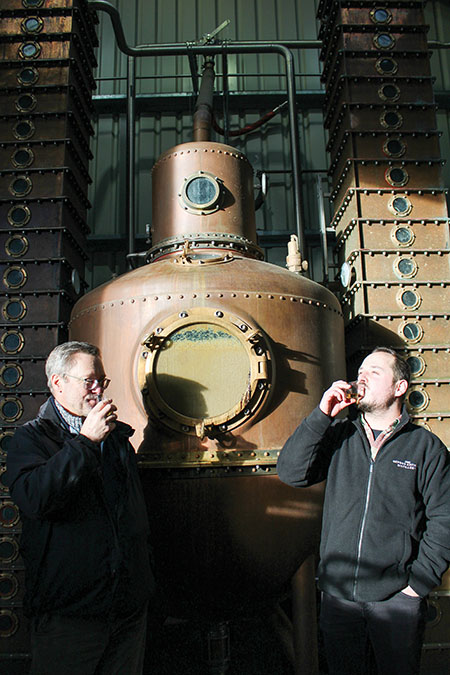
Oxford Artisan Distillery in the UK
The folks at the UK based Oxford Artisan Distillery, work directly with archaeo-botanist John Letts at Heritage Harvest Ltd. In 1994 Letts discovered 200 perfectly preserved examples of wheat and rye landraces in the bottom layers of thatched buildings dating from 1375–1550. He set up his company for flour, but the prospect of producing uniquely profiled whiskey was too much to ignore. Now he supplies grain to distilleries, although malting happens elsewhere.
Prior to these discoveries, little was known about landraces in the UK. These long tracks of land growing mixed grains evolved naturally, and were generally unique to their town. Grain imports nearly collapsed Britain’s agricultural industry 1880s and led to scientists breeding new hybrids to produce high yields in the UK climate. In 1906, the ‘revolutionary victor’ grain was released, but it required artificial fertilizer. During the ‘green revolution’ of the 1960s-70s, herbicide, pesticide and fungicide became an agricultural necessity.
Less variation in grain means less attraction to wildlife and higher chemical use, negatively impacting pollination and soil health. After the harvest, fields were required to be left fallow for four years to allow the soil to recuperate its nutrients. The landscape and farmer’s pocket book suffered.
By revisiting older methods of cultivation, soil isn’t ploughed after harvest. What’s left of the plant breaks down into the field, re-nourishing the soil. Clover that grows naturally, replenishes the soils nitrogen, an essential for growth, filling the role of fertilizers.
“What happened in the first five thousand years of the Neolithic period, that’s what I’m trying to do,” John Letts explains. “There was no evidence of tilling. I thought maybe we can recreate the medieval thatch and grow genetically diverse crops. My challenge was to grow (old-style) crops in a modern way.”
“Farmers see weeds as an enemy. I see weeds as a friend,” Letts continues Thirty percent of the energy of a wheat plant is pumped into the root to source mold and fungi. Insects feed nitrogen back to the plants. “The only thing that leaves the field is the grain. We harvest the grain and leave the stubble. Then we lay the new grain seeds, mow the stubble and that stops the birds from getting to it. That’s how it works in nature, so let’s mimic it.”
John Letts’ artisan grains are used by the Oxford Artisan Distillery. Head Distiller Francisco Rosa uses unique batches of Red Red Rye or Heritage Corn to create unique whiskey flavors. Despite higher prices than spirits distilled from industrial grains, the heritage batches sell well. The trade-off between consistency and grain-specific flavors is understood by customers to be an attractive feature rather than a bug.
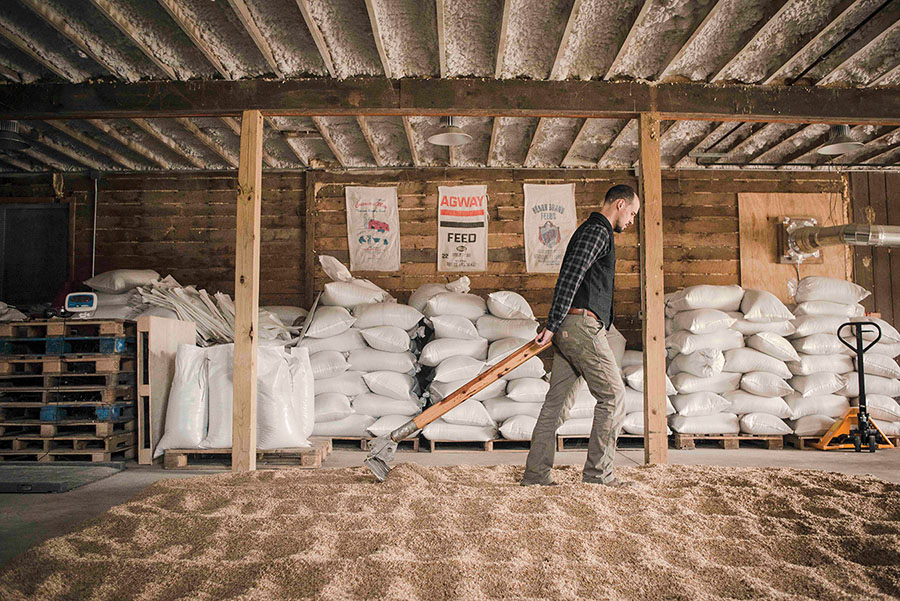
Coppersea, based in New York’s Hudson Valley, produces a whiskey in the spirit of 19th century, traditional time and place of rye cultivation. “As we explored what that meant and tried to understand it, we mostly keyed into this variety of methods.” Explains Chris Briar, the Chief Distiller and Blender at Coppersea. Through years of study and experimentation, they implemented what worked for them, and what didn’t. “We don’t dress in period clothes. This isn’t a museum,” Briar insists. Coppersea is committed to grain grown in the Hudson Valley. This led Chris to get involved in Empire Rye, a consortium of distillers dedicated to establishing a whiskey style for the New York State.
Their commitments mean limited and specific options. They’ve been experimenting with growing on their own farm, utilizing the landrace style farming that The Oxford Artisan Distillery has. Their focus was on regional varieties. Then, to produce the quantities they needed, they had to convince local farmers to grow it. It was a tall ask. They had to offer a higher price, and compromise with varieties that still had a relatively high yield. Nonetheless, over the ten years that they’ve been producing whiskey, they’ve transformed the landscape, working with several farms, and they’re making great drinks that fit their specifications.
They’re still developing their landrace, so any particular year they could harvest and make a whiskey with a vintage, a unique and collectable item. Nonetheless, they couldn’t label it as whiskey, as the mixed grain base didn’t fit the definition. The Oxford Artisan Distillery also confuses category gatekeepers who suggest that their product isn’t a whiskey, as 2% of the mix is wildflowers caught up in the harvest.
And it’s not just about the grain. They’re also implementing heritage methods. Malting their own grain, and open wild fermentation which utilises yeasts from air, amounting to a localised result in flavour and aroma. Direct fire stills and low proof aging all influence the flavour, although there is room to cut a few corners. “We just wanted to make a whisky like it used to taste” says Chris. “The direct fire stills are gas fired rather than wood, it achieves the same result in the flavor so that’s enough for us.” The resulting flavor is created by pyrolysis compounds, heavy, organic compounds created through direct fire.
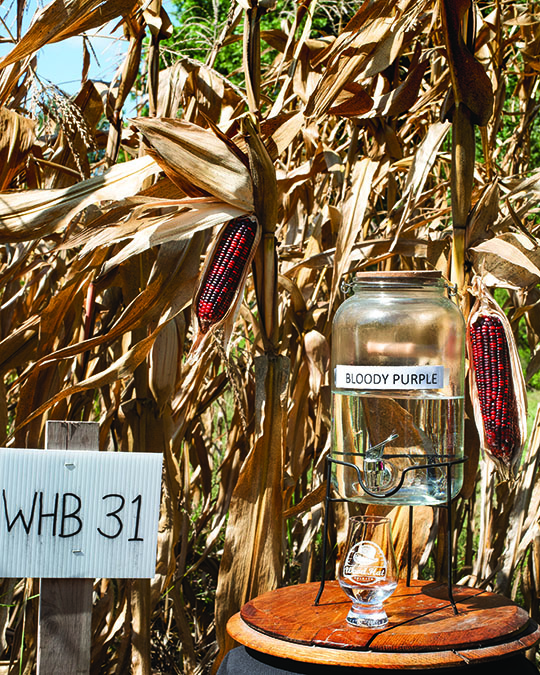
Distiller magazine cover story subject Gary Hinegardner of Wood Hat Distillery outside St. Louis is known as the “pied piper of heritage corn.” Gary forbids use of hybridized Yellow Dent corn in his products. He calls it “pig food.” “Yellow corn doesn’t come in the house,” he laughs. “White corn comes in, yellow stays outside.”
‘Heritage’ is a subjective term dependent on locational history. As far as Gary’s concerned, there are three ages of corn. Anything prior to Columbus is heritage corn. Then Europeans began breeding corn, known as “Grandpas corn,” relating to a small homestead where the corn had been bred down by the family. Then we have industrial hybridization. With a little research, he found that when industrialization began, homesteads began squirreling away seeds from the “Grandpa” collection. These collections were stashed away in banks, and Gary was able to retrieve some of them and sow his own fields. When that field was first ready for harvest, he set up the distillery and he made his first whiskey.
The All-American Red White and Blue Corn Whiskey reflects a mashup of heritage grains. White corn makes a base, smooth and soft. Blue Indian Hopi corn brings an elegance and floral complexity to the palate. And the Bloody Butcher Red corn brings a warm and comforting garam marsala spice later on the palate.
What does brown corn taste like? Brown, apparently. Notes of leather and bitter amaro.
Hinegardner’s goal to create a seedbank where future generations of distillers can say “I want this flavor in my spirit”, and he can recommend the best corn for the job. He’s taking corn in a different direction, one that can appeal at a base level for any craft distiller. Technology has been advancing and with the CRISPR system, genetics can be modified directly, rather than having to crossbreed with different plants to infill missing genes.
Growing heritage corn strains is labor-intensive. These are plants, and they cross pollinate themselves. All it takes is a walk along a field to see plants that have been contaminated by other strains. Paper bags cover fertile silk during pollination seasons.
In September 2022, Hinegardner showcases varieties at a Corn Master Class, which he’s running alongside the ADI Conference in St Louis. A field has been planted, with rows of different varieties and at the end of each row you’ll find a jug of white dog, so you can connect the dots between seeing and smelling the corn, and the distillate. This education in how the grain reacts in that initial distillation process helps determine the potential outcome. There can be wildly different flavors here, which can completely change the character of a spirit. “We’ll have Bloody Butcher. Hopi Indian Blue, Hickory Cane, with others. We’re doing a new corn called Bloody Purple instead of Bloody Butcher. It’s purple in color.” Wood Hat also utilizes unique heritage methods, including a still powered by oil-heated coils.
Consumers are asking more questions of spirits and spirit production, and this creates an opportunity to sell a premium product for a higher price. As Gary explains, “Our yardstick is whether people like to eat it or not. Then you can decide if one makes whiskey from it.” •

